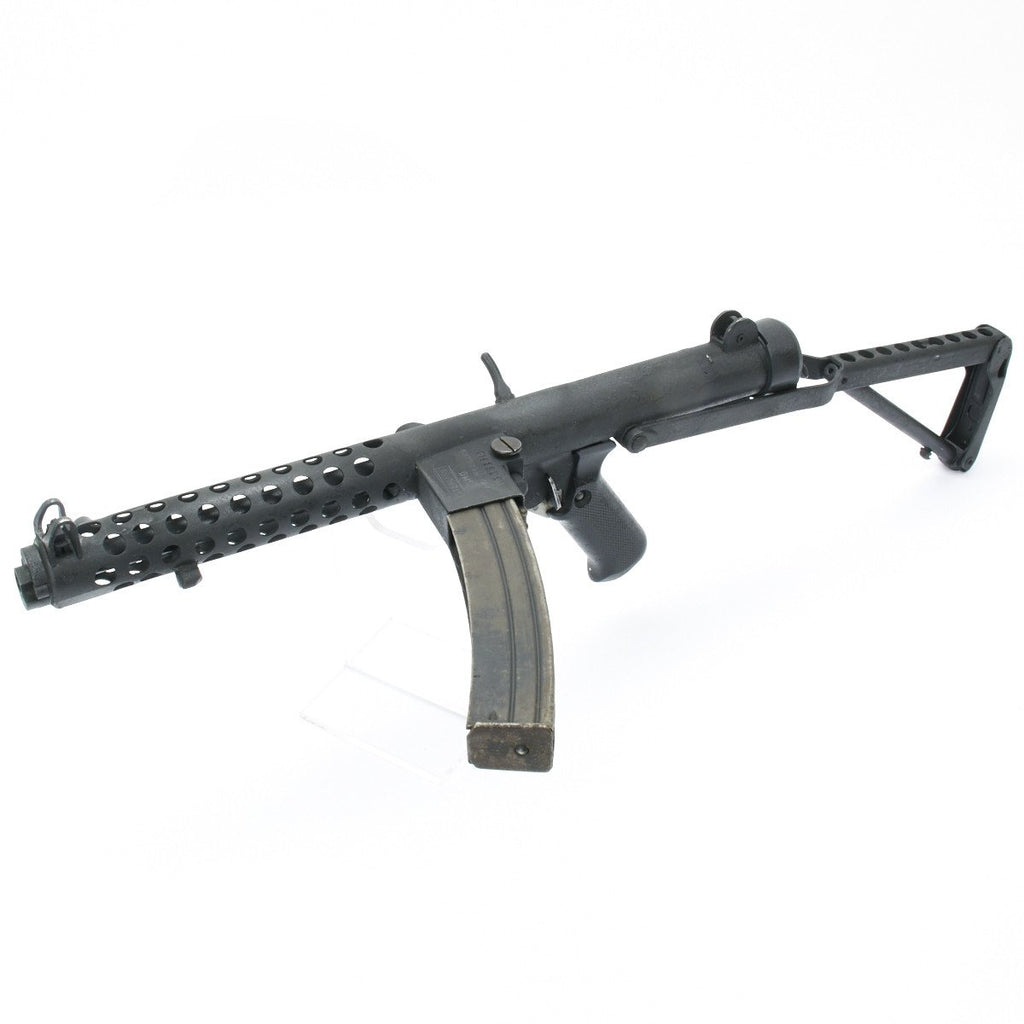Item Description
Original Item: This is our very final run of Sterling Mark 4 (L2A3) display guns. You don't see these often and if you do it has generally been adapted for use in a STAR WARS film. This is the most exciting SMG of post WW2 years, The British 9mm Sterling MkIV SMG!
This display gun is superbly built from all original post WWII parts then fitted with a solid steel totally non-operational BATFE approved display receiver, making it legal to own in the USA. Features of our exclusively built display gun include: correct black crinkle paint finish, fully operational folding stock, original markings, active trigger with satisfying click and it even comes complete with a curved Sterling 9mm Magazine (where permitted).
History of the Sterling submachine gun-
The Sterling submachine gun is a British submachine gun. It was trialled with the British Army in 1944-1945 as replacement for the Sten but it did not start to replace the Sten until 1953. It remained in use until 1994, when it was phased out with the introduction of the L85A1 assault rifle.
n 1944 the British General Staff issued a specification for a new submachine gun. It stated that the weapon should not weigh more than six pounds (2.7 kg), should fire 9×19mm Parabellum calibre ammunition, have a rate of fire of no more than 500 rounds per minute and be sufficiently accurate to allow five single shots to be fired into a one foot square target at 100 yards (91 m).
To meet the new requirement, George William Patchett, the chief designer at the Sterling Armaments Company of Dagenham submitted a sample weapon of new design in early 1944. The army quickly recognised its potential (i.e. significantly increased accuracy and reliability when compared to the Sten) and ordered 120 examples for trials. Towards the end of the Second World War, some of these trial samples were used in combat by airborne troops at Arnhem and elsewhere, where it was known as the Patchett submachine gun. Given that the Patchett/Sterling can use straight Sten submachine gun magazines as well as the curved Sterling design, there were no interoperability problems.
After the war, with large numbers of Sten guns in the inventory there was little interest in replacing them with a superior design. However, in 1947 a competitive trial between the Patchett, an Enfield design, a new BSA design and an experimental Australian design was held, with the Sten for comparison. The trial was inconclusive but was followed by further development and more trials. Eventually the Patchett design won and the decision was made in 1951 for the British Army to adopt it. It started to replace the Sten in 1953 as the Sub-Machine Gun L2A1. Its last non-suppressed variation was the L2A3, but the model changes were minimal throughout its development life.
Sterling submachine guns with minor cosmetic alterations were used in the production of the Star Wars movies as blaster rifle props.
Variants:
British Army
Unassigned: Patchett Machine Carbine Mark 1 (trials commenced in 1944)
Unassigned: Patchett Machine Carbine Mark 1 & Folding Bayonet (same as above but with folding bayonet, never accepted)
L2A1: (Patchett Machine Carbine Mark 2) Adopted in 1953.
L2A2: (Sterling Mark 3) Adopted in 1955.
L2A3: (Sterling Mark 4) Adopted in 1956. Last regular version in service with the British Army.
L34A1: Suppressed version (Sterling-Patchett Mark 5). Held in reserve by the British Army.
- This product is not available for international shipping.
- This item is completely legal within the USA. International Military Antiques, Inc observes all Federal, State and Local laws. Everything for sale on ima-usa.com is completely legal to own, trade, transport and sell within the United States of America. Every display machinegun and machine gun parts set and gun sold by IMA, Inc is engineered to be inoperable according to guidelines provided by the US Bureau of Alcohol, Tobacco, Firearms and Explosives (BATF).
Deactivated magazine will be sent if shipped to the following states due to high capacity magazine restrictions:
California - 10 round maximum for all magazines.
Connecticut - 10 round maximum for all magazines.
Hawaii - 10 round maximum for all magazines.
Maryland - 20 round maximum for all magazines.
Massachusetts - 10 round maximum for all magazines
New Jersey - 15 round maximum for all magazines.
New York- 7 round maximum for all magazines.
- Not eligible for payment with Paypal or Amazon

















